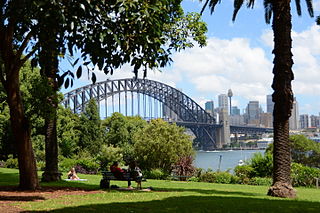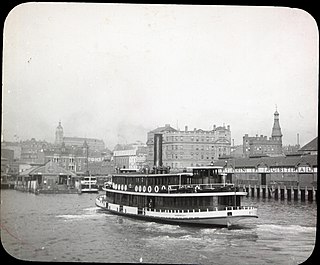
Admiralty House is the Sydney official residence of the governor-general of Australia. It is located in the suburb of Kirribilli, on the northern foreshore of Sydney Harbour. This large Victorian Regency and Italianate sandstone manor, completed in stages based on designs by James Barnet and Walter Liberty Vernon, occupies the tip of Kirribilli Point. Once known as "Wotonga", it has commanding views across Sydney Harbour to the Sydney Harbour Bridge and the Sydney Opera House.

Circular Quay is a harbour, former working port and now international passenger shipping port, public piazza and tourism precinct, heritage area, and transport node located in Sydney, New South Wales, Australia on the northern edge of the Sydney central business district on Sydney Cove, between Bennelong Point and The Rocks. It is part of the local government area of the City of Sydney.

The North Shore is a region within Northern Sydney, in the state of New South Wales, Australia, generally referring to suburbs located on the northern side of Sydney Harbour up to Wahroonga, and suburbs between Middle Harbour and the Lane Cove River.

North Sydney is a suburb and major commercial district on the Lower North Shore of Sydney, New South Wales, Australia. North Sydney is located three kilometres north of the Sydney central business district and is the administrative centre for the local government area of North Sydney Council.

Milsons Point railway station is a heritage-listed railway station located on the North Shore line, serving the Sydney suburb of Milsons Point in New South Wales, Australia. It is served by Sydney Trains T1 North Shore line services. The station is located above ground, accessible via stairs and a lift, in Milsons Point, in the North Sydney Council local government area of New South Wales, Australia. It was designed and built by the Sydney Harbour Bridge Branch of the NSW Department of Public Works. The property was added to the New South Wales State Heritage Register on 2 April 1999.

Milsons Point is a suburb on the lower North Shore of Sydney, in the state of New South Wales, Australia. The suburb is located 3 kilometres north of the Sydney central business district in the local government area of North Sydney Council.

Lavender Bay is a harbourside suburb on the lower North Shore of Sydney, New South Wales, Australia. Lavender Bay is located 3 kilometres north of the Sydney central business district, in the local government area of North Sydney Council.

McMahons Point is a harbourside suburb on the lower North Shore of Sydney, New South Wales, Australia. McMahons Point is located 3 kilometres north of the Sydney central business district, in the local government area of North Sydney Council. McMahons Point sits on the peninsula flanked by Berrys Bay to the west and Lavender Bay to the east. The lower tip of the peninsula is known as Blues Point, which offers expansive views of Port Jackson. The postcode is 2060.

Loreto Kirribilli is an independent Roman Catholic comprehensive single-sex primary and secondary day school for girls, located in Kirribilli, a Lower North Shore suburb of Sydney, New South Wales, Australia.

Milsons Point ferry wharf is located on the northern side of Sydney Harbour serving the Sydney suburb of Milsons Point. It is next to Luna Park and the Sydney Harbour Bridge. It is served by Sydney Ferries Parramatta River and Pyrmont Bay services operated by First Fleet and RiverCat class ferries.
Inner Harbour ferry services was a name used for ferry services connecting suburbs on the foreshore of the inner Sydney Harbour with Circular Quay by commuter ferry. Since 2017 this name is no longer used and all services have reverted to individual names

Northern Sydney is a large metropolitan area in Greater Sydney, New South Wales, Australia on the north shore of Sydney Harbour and Parramatta River. The region embraces suburbs in Sydney's north-east, north and inner north west. Northern Sydney is divided into distinctive regions such as the North Shore, Northern Beaches and Forest District.

Jeffrey Street or Jeffreys Street is a street located in Kirribilli, famous for being one of the most popular vantage points for views of the city skyline of Sydney, the Sydney Harbour Bridge and the Sydney Opera House. The street is located on the Lower North Shore of Sydney Harbour, directly across the harbour from Circular Quay and is a popular destination for tourists, particularly on Australia Day and New Year's Eve. The street leads uphill from the harbour in a northerly direction to the small shopping village of Kirribilli. For many years the area was called the North Shore and the original land grant changed hands a number of times. Over the past 200 years the area has also been called Huntershill, St Leonards, North Sydney, "Kiarabilli", Milsons Point and "Kirribilli Point". The modern spelling Kirribilli was first used in 1853 and the use of Kirribilli as a locality is more recent.

Colonel John George Nathaniel Gibbes was a British army officer who emigrated to Australia in 1834 on his appointment as Collector of Customs for the Colony of New South Wales, an appointment which gave him a seat on the New South Wales Legislative Council and which he held for 25 years.

The Kirribilli Neighbourhood Centre occupies two restored old stone houses, known as 16 and 18 Fitzroy Street at the northern end of Jeffrey Street, Kirribilli. The houses were built by Henry Hocken Bligh in 1875-1876. Bligh was born on 19 October 1826 in Bodmin, Cornwall England and died at his home on 30 July 1904. The houses were acquired by North Sydney Council in 1974 and the modern day Kirribilli Neighbourhood Centre opened in 1976.
Sydney Ferries Limited operated ferry services on Sydney Harbour from 1900 until June 1951.

Neutral Bay ferry services is a commuter ferry route in Sydney, New South Wales, Australia. Part of the Sydney Ferries network, it serves several Lower North Shore suburbs around Neutral Bay.
The Mosman Bay ferry service is a commuter ferry route in Sydney, New South Wales, Australia. Part of the Sydney Ferries network, it serves several Lower North Shore suburbs around Mosman Bay.

Koree was a "K-class" ferry on Sydney Harbour. Launched in 1902, the timber-hulled steamer was built for Sydney Ferries Limited during the boom in cross-harbour ferry travel prior to the opening of the Sydney Harbour Bridge.

Kurraba and Kirribilli were two similar "K-class" ferries on Sydney Harbour. Launched in 1899 and 1900 respectively, the two timber-hulled steamers were built for Sydney Ferries Limited during the boom in cross-harbour ferry travel prior to the opening of the Sydney Harbour Bridge.
































